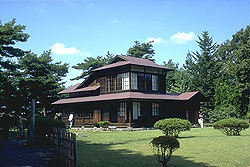
|
The building utilized by the Rasu Farmers Association was removed and reconstructed on the grounds of Hanamaki Agricultural High School, where it is maintained by the association's alumni.
"Spring at Ihatov Agricultural School"
It's the reflection of the blinding snow on the mountain. When I'm working or lifting something heavy and I can't scoop up any water or even think about taking a drink, that white light draws near to my throat like ice and goes down it in gulps, completely curing my thirst.
It's spring-let's sing and run and leap for joy. Kazano Matasaburo [Matasaburo the Wind Imp], goes leaping through the fields with his glass cape fluttering and his hair flying behind him, singing "spring has come." So run and sing and leap for joy.
The Complete Works of Miyazawa Kenji Vol.6, Chikuma Bunko
Cold Summers and Crop Shortages
When Kenji taught agronomy at Hanamaki Agricultural School, and later at the Rasu Farmers Association, he wrote a great number of fertilizer prescriptions at the request of farmers in the area. One problem that was important to Kenji was how best to prevent damage to rice crops during cold summers when temperatures didn't rise high enough at the time the rice started to ripen.
"Gusukou Budori, a Biography"
There's no telling why, but that year the sun took on a whitish cast from springtime on, and the magnolia trees that always bore pure white flowers as soon as the snow melted didn't bloom at all. Even in May a mushy sleet often fell. At the end of July it still hadn't warmed up, so all that came up of the wheat planted the year before were white ears with no grain on them, and the flowers on nearly all of the fruit trees bloomed and then just dropped off with bearing any fruit.
Finally autumn came, but the chestnut trees only gave green burs, and the precious oriza [Latin for rice] crop that everyone depended on as a staple food produced not even a single grain.
The Complete Works of Miyazawa Kenji Vol.8, Chikuma Bunko
